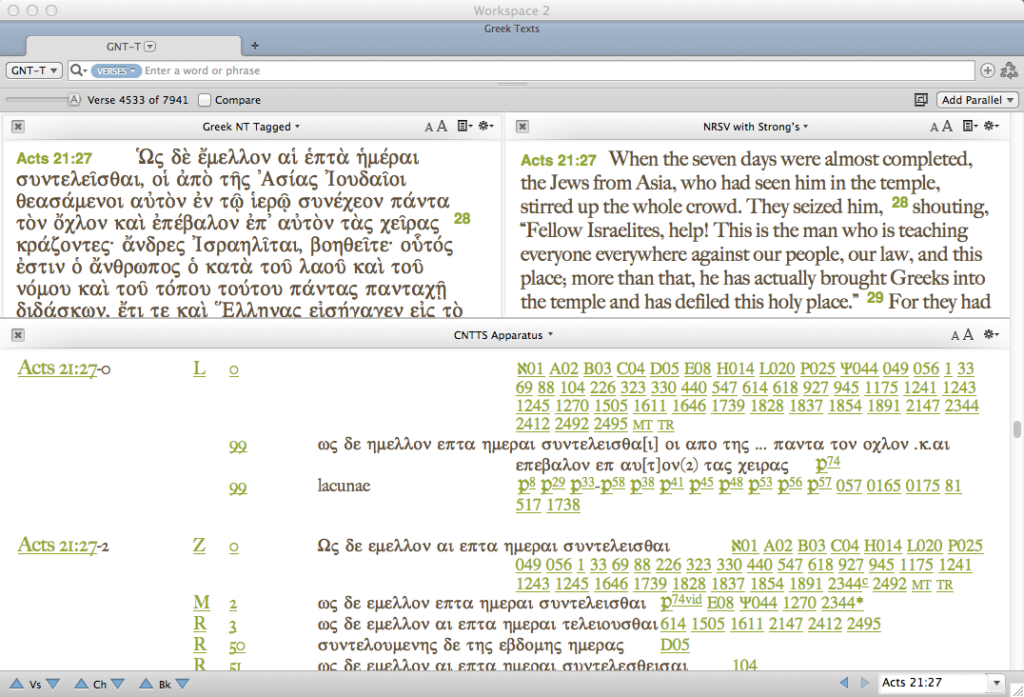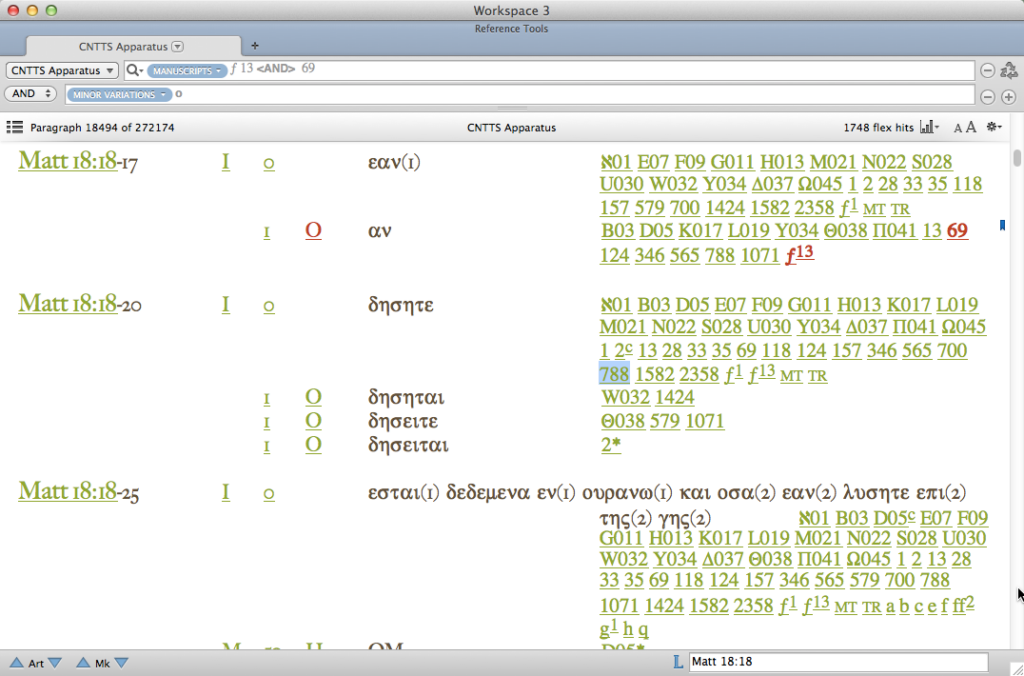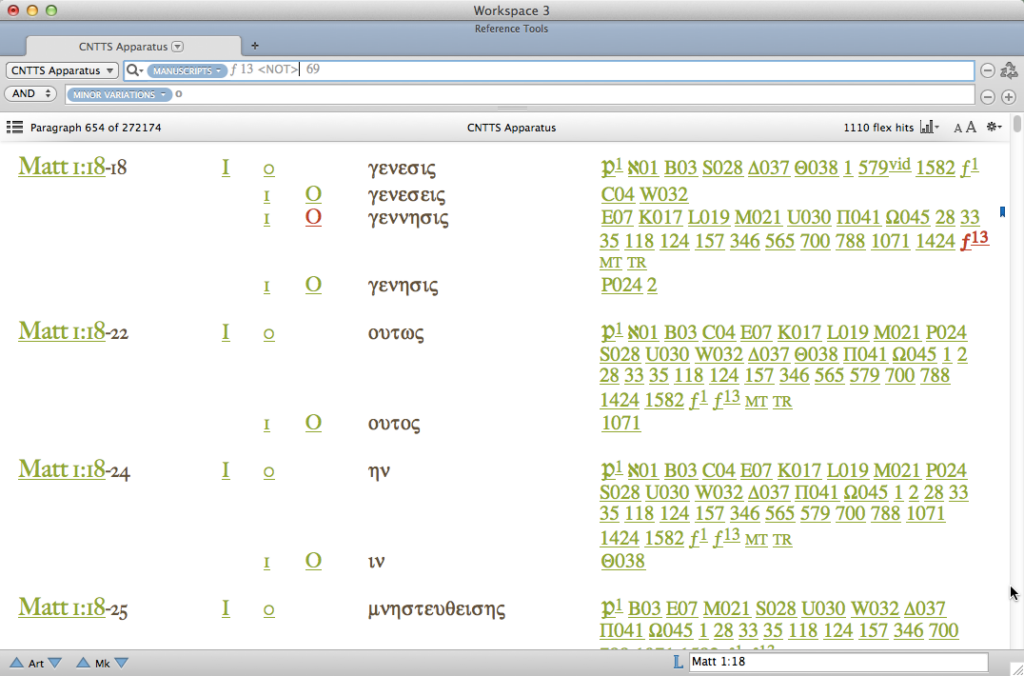 Introduction
Introduction
The CNTTS Apparatus is a very special database in a number of ways: scope, functionality, and even intended use. It has great potential that goes far beyond traditional critical apparatuses. With this in mind we will begin this brief article talking for just a moment about traditional critical studies and critical apparatus in very broad terms. Then we will move on to discuss some of the new directions that critical studies are moving, and to see how this apparatus grows out of and has the potential to influence wider developments in the field. Finally we will spend some time discussing the functionality of the Apparatus and how to use it.
 Traditional Textual Criticism & Critical Apparatuses
Traditional Textual Criticism & Critical Apparatuses
The traditional goal of textual criticism, critical editions of works, and the critical apparatus that goes with them has always been the reconstruction of the original text. A cursory glance at the introductions of the NA27 or the UBS4 editions of the Greek New Testament bears this out. A pragmatic result of this objective is that the variant readings cited in a traditional apparatus are limited in scope. Decisions are made by the editors of these editions, and the most important readings are included, while many others are left out. Unfortunately, such an approach will always be saddled with a certain degree of subjectivity. Furthermore, there is only so far we can go in this direction of trying to reconstruct the original text. Even if we were to discover an original autograph, how would we know?
 New Directions in Critical Studies
New Directions in Critical Studies
Recently, however, textual criticism has begun to move in new directions with efforts being made to create critical editions and apparatus that present all of the witnesses of the Greek New Testament, like the International Greek New Testament Project, without prejudice to their importance, or significance. Reuben Swanson has done a great deal of work in this area, creating his own columned approach in his New Testament Greek Manuscripts: Variant Readings Arranged in Horizontal Lines Against Codex Vaticanus series. Unfortunately, this arrangement is better suited to print publishing, and is limited in the number of manuscripts witnessed. Nevertheless, Swanson makes an excellent case for the need of a comprehensive presentation of manuscript evidence in his Introduction to the Romans volume (see p. xxv-xxx). The bottom line is that there are so many things we may learn from each manuscript when it is viewed in contrast to the others. As Swanson points out, each one of these manuscripts was the Word of God to an entire community at some point; there is much to be unearthed about these communities from the way their scriptures vary from others.
 The CNTTS Apparatus
The CNTTS Apparatus
So, into this evolving world of Textual Criticism enters The Center for New Testament Studies NT Critical Apparatus. This is the first Critical Apparatus designed and published for computerized study of the New Testament. Although it is not yet complete, its intent from the beginning is to be exhaustive, with every manuscript reading, no matter how large or small, included. The base text to which the manuscript variations are collated is the standard UBS4 eclectic text. This means this database can function just fine as an apparatus, but since it is designed to function as a computer database, it is even more interesting to search it on its own.
 How to Use It
How to Use It
First, there is the obvious use as a traditional apparatus in conjunction with the eclectic text. Notice the long lists of manuscripts cited. The CNTTS Apparatus functions very well in this way offering a great deal more information on any passage, than would normally be available to the reader.
But, lets look at a search of the database itself to see some of the real power available here. For instance, lets see if we can see how closely minuscule 69 follows ƒ13 in orthographic variations. First we will do a search for ƒ13 <AND> 69 with an orthographic variant in the same paragraph. This means both the family and the manuscript witness the same variation from the UBS text.
Next, we will search for ƒ13 <NOT> 69 with an orthographic variant in the same paragraph. Now we are looking at instances where 69 does not witness the same orthographic variant as its family of manuscripts. In many instances it supports the base reading of the UBS4 but not always.
Using the keep feature in the Hits Graph quickly shows that 69 agrees (red) with its family more than it disagrees (blue), except in the beginning of Matthew, where the manuscript is lacking. That said, there are still a significant amount of places where 69 differs from its family.
We have really only scratched the surface of this amazing tool, but hopefully this is enough to help us to begin to imagine the potential research that can be done with an apparatus like this in Accordance. For a complete list of the all the variation codes on which the Apparatus can be searched, please see the CNTTS Textual Database Information, which includes an explanation of the layout and symbols and can also be viewed at the head of the module itself.
 The Future
The Future
Of course the key to the functionality of a tool like this is its comprehensiveness. The first priority is to get the complete corpus represented in the manuscript. As of this article, the Gospels, Acts, and the General Epistles are present with over 100 manuscript witnesses, but the Center For New Testament Textual Studies anticipates the remainder of the corpus by this fall (2007). Future updates will add collations of additional manuscripts with the goal of adding every manuscript possible.
Update: November 2009 saw the release of the entire New Testament in the CNTTS.
Click here to order the CNTTS module.





